 While The Flowing Tide serves as Northside Dublin’s premier theatrical pub, with its close associations with the neighbouring Abbey Theatre (and its short walk to The Gate), Neary’s takes on that role on the Southside for the Gaiety Theatre. Alas, though, one of the finest theatrical tales about Neary’s seems to be a bit of a myth. In Donal Fallon’s excellent new book, The Dublin Pub: A Social and Cultural History (a must-have for any pub nerd), the story of Alan Devlin storming offstage at the Gaiety during a production of HMS Pinafore* and demanding drink at Neary’s is only true…in part.
While The Flowing Tide serves as Northside Dublin’s premier theatrical pub, with its close associations with the neighbouring Abbey Theatre (and its short walk to The Gate), Neary’s takes on that role on the Southside for the Gaiety Theatre. Alas, though, one of the finest theatrical tales about Neary’s seems to be a bit of a myth. In Donal Fallon’s excellent new book, The Dublin Pub: A Social and Cultural History (a must-have for any pub nerd), the story of Alan Devlin storming offstage at the Gaiety during a production of HMS Pinafore* and demanding drink at Neary’s is only true…in part.

In reality, it seems Devlin only made it as far as Sinnott’s, just steps away…so while Neary’s have claimed the (delightful) story, it’s actually more accurately one that belongs to the whole street. But Neary’s has featured in other legendary activities, too – Nell McCafferty famously led a protest here in 1974, demanding that women be served pints (THINK OF THE CHILDREN), and a version of the story makes its way into the book as well; the good news is that once again, there’s more than a grain of truth here.
 And it is, perhaps, fitting that Neary’s is a pub that attracts this kind of lore; its beautifully-maintained interior hearkens back to the 1880s – well, at least in the main bar downstairs – while upstairs, it’s a slightly more updated restaurant feel, but still elegantly understated. The working gas lamps and dumbwaiter inside are well-known historical features, but the literally hand-held lamps outside are iconic.
And it is, perhaps, fitting that Neary’s is a pub that attracts this kind of lore; its beautifully-maintained interior hearkens back to the 1880s – well, at least in the main bar downstairs – while upstairs, it’s a slightly more updated restaurant feel, but still elegantly understated. The working gas lamps and dumbwaiter inside are well-known historical features, but the literally hand-held lamps outside are iconic.
Despite its history and location next to the Gaiety, it doesn’t feel quite as ‘theatrical’ as The Flowing Tide – the subject of its own chapter in The Dublin Pub – but it wears its literary heritage very well indeed. Pints-wise (and yes, anyone of age can have those pints now), O’Hara’s is the independent option, with the usual Guinness as well. Our small quibble would be the unused/possibly not real hand pumps – regular readers know we feel A Way about cask ale – but they do seem part of the furniture here.
Of course, we’ve only scratched the surface here; Dublin’s pubs have so many fantastical stories – some more fact-based than others – and we cannot recommend Donal’s book highly enough. Consider this your call to action to pick up a copy if you have not already done so!
It’s an ideal read for an afternoon with a book and a solo pint.
Where: 1 Chatham Street
Access from the city centre: You are in it
Food: Sandwiches (toasties and more), salads, oysters
Sport: Not here
TVs: None at all
Music: Quiet jazz upstairs in the Lounge, occasional live sets
Family-friendliness: A surprisingly large number of babies and toddlers mid-afternoon
Pub-crawl-ability: High – The Hairy Lemon, Caribou, Bar Rua, The Long Hall, Grogan's, Peter's Pub, Sinnott's Bar and more are all within a short wander
Local sites of note: Gaiety Theatre, Craft Central (absolutely a landmark for the beer nerds), Little Museum of Dublin, George's Street Arcade, St Stephen's Green, Grafton Street
Haunted: There’s a story of a deceased punter…so perhaps!
Other notes: While there is the dreaded (by us) Changing Times Hazy IPA, there’s still the aforementioned O’Hara’s
Socials: Instagram, Facebook
*FWIW, your fair scribe has been in many productions of HMS Pinafore, and could easily step into essentially any role if need be, as long as some transposing down were a possibility for anything higher than mezzo. But Sir Joseph? Yes, could absolutely do it. And so could our sisters and our cousins and our aunts…

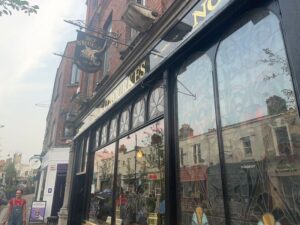 We know that we tend to be biased toward pubs on the north side of the Liffey, but this week, we travel (relatively) far into south Dublin – all the way to Blackrock and . Once a quiet fishing village with a sideline in
We know that we tend to be biased toward pubs on the north side of the Liffey, but this week, we travel (relatively) far into south Dublin – all the way to Blackrock and . Once a quiet fishing village with a sideline in 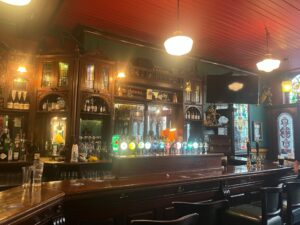 And while the
And while the 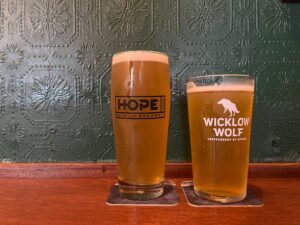 There are some lovely little snugs and the pub also has a bit of a nautical bent – the seafront is right here, after all – but it’s very welcoming to all; the standard Guinness (and Beamish!) is on offer, and there is good support for independent offerings like Hope and Wicklow Wolf, as well as
There are some lovely little snugs and the pub also has a bit of a nautical bent – the seafront is right here, after all – but it’s very welcoming to all; the standard Guinness (and Beamish!) is on offer, and there is good support for independent offerings like Hope and Wicklow Wolf, as well as 
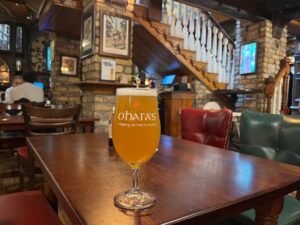 The staircase formerly connected floors in Trinity College, and the beer garden out back can even be heated when necessary (though as with so many of the more interior-feeling beer gardens in Dublin, it can tend toward feeling very smoky). All told, it feels very ‘pubby,’ but what strikes me is the very noticeable vibe shift when the tour groups leave. It took a few visits to realise that it wasn’t just the freeing up of part of the pub that made the real difference; rather, it was the music. When the groups are in, the music is not just trad (there is, after all, plenty of good trad out there), but full-on diddly-eye trad – the sort of music that might have been featured on an American PBS station 40+ years ago. But once they go, there’s a break – either no music, or a change to something a bit more current. Perhaps it’s coincidence, but it’s something we’ve noticed on multiple visits – and it’s no bad thing!
The staircase formerly connected floors in Trinity College, and the beer garden out back can even be heated when necessary (though as with so many of the more interior-feeling beer gardens in Dublin, it can tend toward feeling very smoky). All told, it feels very ‘pubby,’ but what strikes me is the very noticeable vibe shift when the tour groups leave. It took a few visits to realise that it wasn’t just the freeing up of part of the pub that made the real difference; rather, it was the music. When the groups are in, the music is not just trad (there is, after all, plenty of good trad out there), but full-on diddly-eye trad – the sort of music that might have been featured on an American PBS station 40+ years ago. But once they go, there’s a break – either no music, or a change to something a bit more current. Perhaps it’s coincidence, but it’s something we’ve noticed on multiple visits – and it’s no bad thing! Now, this is not to say that some of the more touristy pubs are doing their customers a disservice in any way; to the contrary, they are doing a great job of catering to multiple demographics, and more power to them. And Nancy Hands also does a great job of supporting local writers –
Now, this is not to say that some of the more touristy pubs are doing their customers a disservice in any way; to the contrary, they are doing a great job of catering to multiple demographics, and more power to them. And Nancy Hands also does a great job of supporting local writers – 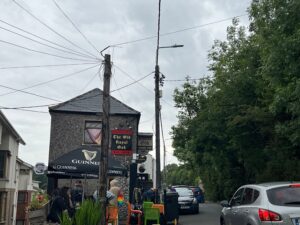
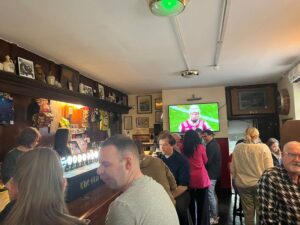 Inside, the look is all Old Man Pub, but with a more diverse clientele of all ages, genders and dog breeds. There’s also good support for local independent beer from Rye River, but they also get accolades a-plenty for the Guinness here. On our visit, the hurling was on (ironically, I was trying to get as far from
Inside, the look is all Old Man Pub, but with a more diverse clientele of all ages, genders and dog breeds. There’s also good support for local independent beer from Rye River, but they also get accolades a-plenty for the Guinness here. On our visit, the hurling was on (ironically, I was trying to get as far from  This week, it’s another relatively rare visit into the more touristy part of town as we visit
This week, it’s another relatively rare visit into the more touristy part of town as we visit 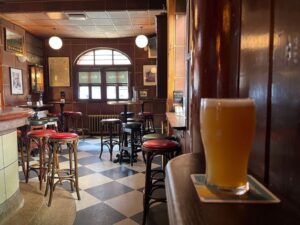 Kennedy’s is another pub I’ve walked past many times without entering, but I finally had a bit of free time in the area this week, so stopped in for a sneaky daytime glass after visiting the National Gallery. While not nearly as extensive a list of craft beer taps as nearby
Kennedy’s is another pub I’ve walked past many times without entering, but I finally had a bit of free time in the area this week, so stopped in for a sneaky daytime glass after visiting the National Gallery. While not nearly as extensive a list of craft beer taps as nearby  There’s a lovely tiled bar in the basement for live music and events, and this space as well as the terra cotta decoration on the pub’s exterior add unique touches, while the rest of the interior feels a bit more ‘standard Irish pub.’ All told, it’s probably more of a destination for those on literary walking tours than anything else, but it’s nice to find a spot in tourist-land with a few craft beers; it’s not necessarily a given in Dublin.
There’s a lovely tiled bar in the basement for live music and events, and this space as well as the terra cotta decoration on the pub’s exterior add unique touches, while the rest of the interior feels a bit more ‘standard Irish pub.’ All told, it’s probably more of a destination for those on literary walking tours than anything else, but it’s nice to find a spot in tourist-land with a few craft beers; it’s not necessarily a given in Dublin.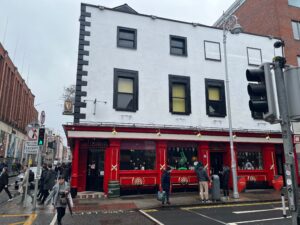 Sometimes, it really is all about The Socials.
Sometimes, it really is all about The Socials.
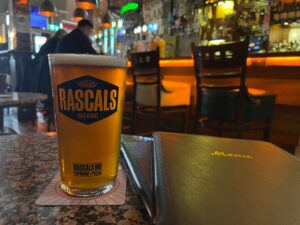
 Last week, we asked whether
Last week, we asked whether 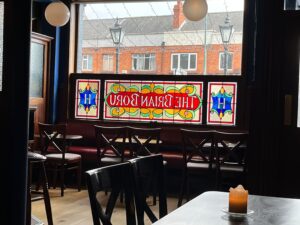 The pub has been here since the 1850s, and in the Hedigan family since 1904, and you can’t miss their name in neon, either. Of course, like so many pubs along this route, it’s name-checked in Ulysses, and has a useful write-up
The pub has been here since the 1850s, and in the Hedigan family since 1904, and you can’t miss their name in neon, either. Of course, like so many pubs along this route, it’s name-checked in Ulysses, and has a useful write-up 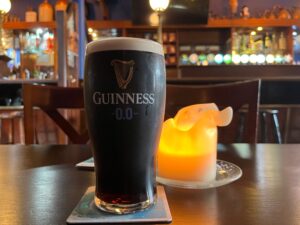 Well, there have been proposals to
Well, there have been proposals to 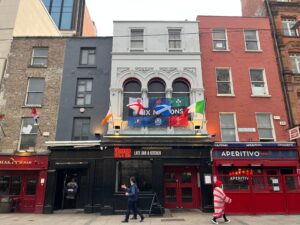 Back in the day – you know, perhaps 3 years ago – this week’s pub was The Porterhouse Central. It was a very handy spot in that you could enjoy a mix of interesting beers from Porterhouse and various guest options, but you avoided
Back in the day – you know, perhaps 3 years ago – this week’s pub was The Porterhouse Central. It was a very handy spot in that you could enjoy a mix of interesting beers from Porterhouse and various guest options, but you avoided 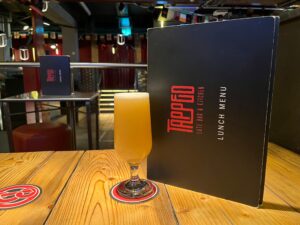 However, I happened to be in the area and had a bit of time after a meeting, so I gave Tapped another try. I’m pleased to say that the interior, while still feeling just slightly too ‘taproom’ has been softened and improved. There is now much more comfortable seating and the lighting is more dialled-in; it feels warmer on the whole. There are screens showing the beer lineup,
However, I happened to be in the area and had a bit of time after a meeting, so I gave Tapped another try. I’m pleased to say that the interior, while still feeling just slightly too ‘taproom’ has been softened and improved. There is now much more comfortable seating and the lighting is more dialled-in; it feels warmer on the whole. There are screens showing the beer lineup, 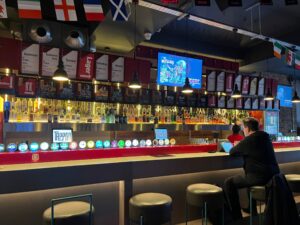
 This week’s pub is one that we’ve both been asked to profile repeatedly, and, in nearly equal measure, begged not to reveal it as a secret hidden gem. Is it possible to satisfy both of these audiences? Let’s find out – and so, we venture back to Marlborough Street, home to
This week’s pub is one that we’ve both been asked to profile repeatedly, and, in nearly equal measure, begged not to reveal it as a secret hidden gem. Is it possible to satisfy both of these audiences? Let’s find out – and so, we venture back to Marlborough Street, home to  Also unlike many other Old Man Pubs, there was an independent beer option: Kinnegar’s Scraggy Bay. In some pubs that don’t have that kind of turnover for non-Guinness options, they aren’t always as fresh, but there were no such issues here. Guinness was, of course, plentiful, but there were many pints of lager being consumed, too – it is slightly unusual to see Tuborg on one of the taps in a Dublin pub, but I have a soft spot for many Carlsberg products, so it was quite welcome. The décor is, again, by no means fancy, but it’s very well-kept: red and cream paint, lighter wood tones and simple brass lamps on the bar. The crowd was clearly mostly regulars, and although most were deeply invested in the multiple channels of horse racing, there were other long-running conversations, too.
Also unlike many other Old Man Pubs, there was an independent beer option: Kinnegar’s Scraggy Bay. In some pubs that don’t have that kind of turnover for non-Guinness options, they aren’t always as fresh, but there were no such issues here. Guinness was, of course, plentiful, but there were many pints of lager being consumed, too – it is slightly unusual to see Tuborg on one of the taps in a Dublin pub, but I have a soft spot for many Carlsberg products, so it was quite welcome. The décor is, again, by no means fancy, but it’s very well-kept: red and cream paint, lighter wood tones and simple brass lamps on the bar. The crowd was clearly mostly regulars, and although most were deeply invested in the multiple channels of horse racing, there were other long-running conversations, too.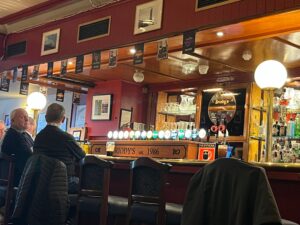 And while it may be true that this is not the cleanest nor most well-kept part of Dublin, that is presumably part of what keeps the tourists away, Georgian architecture notwithstanding. And although some parts of Reddit may be thoroughly convinced that we’re all just waiting to get murdered north of the Liffey, there are signs of positive development; newer pubs like The Morris Bar, just a short walk away, suggest that things are slowly improving. But for a pub like Briody’s that’s been here for over a century in various guises, it seems to be content to keep its current mix of regulars and semi-regulars who drop in whenever they are in town.
And while it may be true that this is not the cleanest nor most well-kept part of Dublin, that is presumably part of what keeps the tourists away, Georgian architecture notwithstanding. And although some parts of Reddit may be thoroughly convinced that we’re all just waiting to get murdered north of the Liffey, there are signs of positive development; newer pubs like The Morris Bar, just a short walk away, suggest that things are slowly improving. But for a pub like Briody’s that’s been here for over a century in various guises, it seems to be content to keep its current mix of regulars and semi-regulars who drop in whenever they are in town.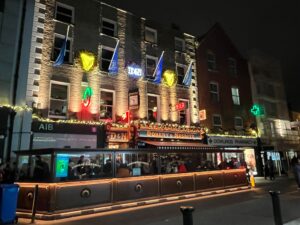 We kick off our 2025 pub-visiting endeavours with a stop off at
We kick off our 2025 pub-visiting endeavours with a stop off at  Its more
Its more  Some of that may also come from its beer selection; there’s the usual Guinness-and-macros lineup (plus Murphy’s), as well as two new taplines from
Some of that may also come from its beer selection; there’s the usual Guinness-and-macros lineup (plus Murphy’s), as well as two new taplines from